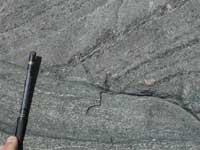On the land surface
Several UPV/EHU groups investigate the processes that occur in the deepest layer of the earth's surface and in the upper part of the mantle. To do this we analyze some rocks that were in the past at great depth.
In the Iberian peninsula there are few rocks that have been buried more than 60-70 km deep. One of these places, known as the northwest allochthonous complex, has been researched by UPV geologists.
Discovering the past of rocks
In the research work of geologists it is essential to identify and collect the appropriate rocks, since the structure of these rocks preserves the history of their formation and, in this case, the processes that occur in the deepest layer of the earth's crust.

Eclogita located in Cabo Ortegal (Galicia), high density metamorphic rock formed by garnets and clinkiroxenes. (Photo: J. I. Gil).
Firstly, a mapping or geological map of the area in which these rocks are located is performed, while analyzing their macrostructure, that is, the spatial arrangement of the elements visible to the naked eye. At the same time, the most suitable rocks are selected for microscopic studies. For these studies the rocks are cut and pressed into thin transparent sheets of 30 microns thick. They carry out geocronological, paleomagnetic or geochemical studies of elements and isotopes.
In fact, the composition and relation of the minerals of these rocks serves to know the conditions in which the rocks were formed; the analysis of the deformations allows to know the behavior of the rocks in the deepest part of the earth's surface, and the study of the radiogenic isotopes allows to deduce the nature of the rocks and when deformations and processes of recristalization occurred.
Other samples are used to know the origin of the rocks, that is, their origin in the continental or oceanic crust or in the mantle under the earth crust.
Results
The work done by the research team in the last two decades has yielded very interesting results. According to these results, the rocks of the allochthonous complexes of the northwest of the Iberian Massif were born 450-500 million years ago. In some cases they were formed in the form of basalts at the bottom of the sea, which were subsequently buried more than 60 km deep (subduction process). There, the so-called ecologites became very dense rocks.
This process of subduction is probably due to the movements of two or more plates, which are believed to have caused the closure of the ancient ocean or sea known as Rheiko. This happened 380-400 million years ago.
Later, the eclogites and other rocks related to them emerged in the form we now know, a process that lasted between 20 and 30 million years. This last return to the earth's surface is estimated to have occurred 300 million years ago. Therefore, they have been able to reconstruct a long and complex history and, in addition, have known some of the processes that occur in the deepest part of the earth's crust, still today, hardly understandable by direct observation.
- Project title Origen y evolución tectónico-thermal de los complejo alóctones del noroeste del macizo ibérico.
- Objective To deepen the knowledge of the evolution of the Earth's lithosphere through the analysis of the orogenic processes taking place in the deepest areas of the earth's surface.
- Director I. Gil Ibarguchi, B. Albalos Villaro.
- Working group M. Mount Aranguren, P. Puelles Olarte, J. F. Santos Zalduegi, L. A. Ortega Cuesta, M. Carracedo Sánchez, A. Alonso Olazabal, L. Eguiluz Alarcón.
- Mineralogy Division – Department of Petrology and Geodynamics.
- • Faculty of Science and Technology





